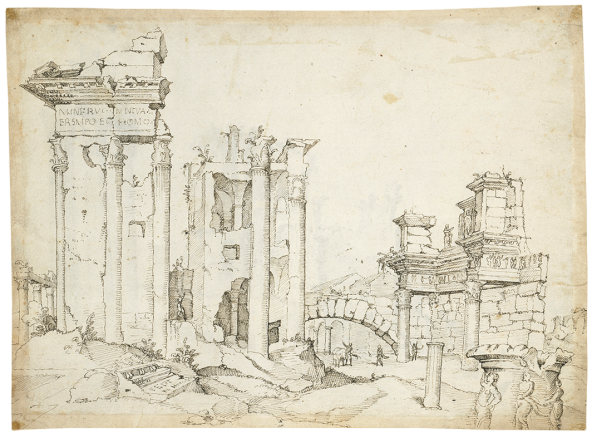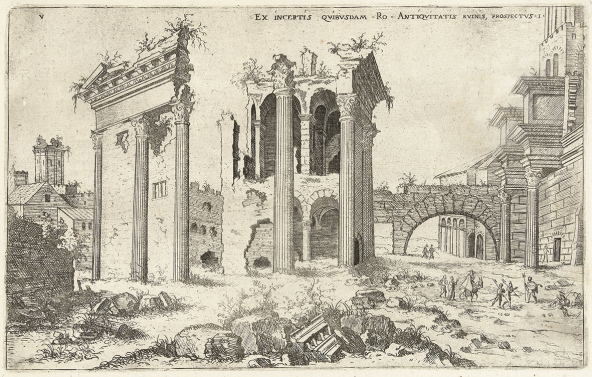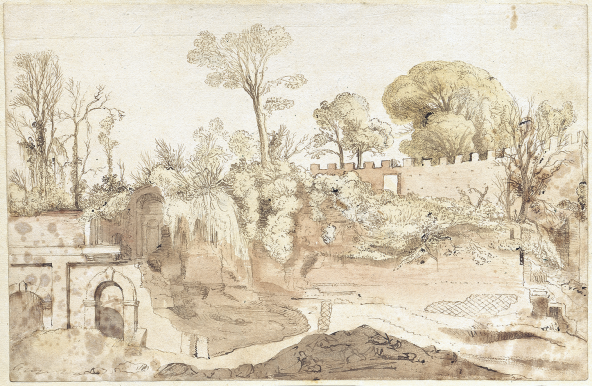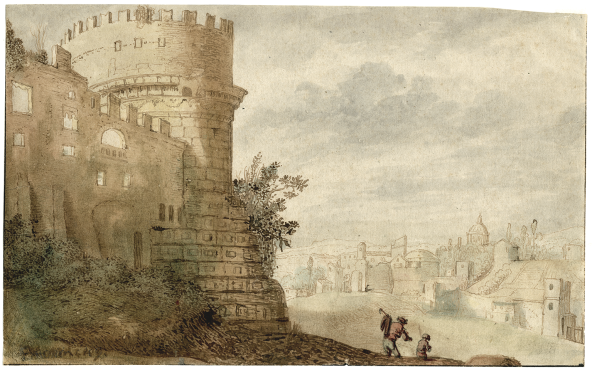Choose a background colour
Attributed to Cornelis Hendriksz. Vroom, Dutch, c. 1591-1661
:
Ruins of the Temple of Minerva in the Forum of Nerva, c. 1610-20
Pen and brown ink with brown wash and rose wash (perhaps made with red chalk) on paper; framing lines in graphite.
7 15⁄16 × 11 3⁄4 in. (20.2 × 29.9 cm)
Verso, lower left, in pencil, T. WYK, upper left, Thomas, center, 60, and lower right, 68714.
- Chain Lines:
- Horizontal, 25 – 27 mm. (25|26|27)
- Watermark:
- None.
- Provenance:
H. C. Valkema Blouw, 1883 – 1953, Amsterdam (Lugt 2505); his sale, F. Muller, Amsterdam, 2 – 4 March 1954, within lots 725 – 34; sale, Mak van Waay, Amsterdam, 25 November 1971, within lot 687 (as Dutch School, nineteenth century); Hans van Leeuwen, 1911 – 2010, Amerongen (Lugt 2799a, stamp on verso); his sale, Christie’s, Amsterdam, 24 November 1992, lot 220; Sheldon and Leena Peck, Boston (Lugt 3847); gift to the Ackland Art Museum, inv. no. 2017.1.95.
- Literature/Exhibitions:
Utrecht 1959– 60, no. 109; Utrecht 1978, no. 109; Bremen 1979, no. 152 (as Cornelis Vroom); Fribourg, Passau, Trier, Aachen & Nuremberg 1982 – 84, no. 114; Keyes 1982, 119 – 20, pl. 10; F. Robinson in Chapel Hill, Ithaca & Worcester 1999 – 2001, 112 – 13, no. 39.
- Ackland Catalogue:
- 2017.1.95
Beginning in the sixteenth century, Dutch artists working in Rome regularly made drawings of ancient ruins as source material to include in their historical paintings. This drawing shows an oblique view of the remains of the Temple of Minerva, which once stood in the Forum of Nerva. As early as 1592, marble blocks and columns from the temple were reused in new building campaigns and in 1606, Pope Paul V ordered all remaining elements dismantled for other projects, including a fountain bearing his name. The Peck drawing is one of only a handful of images that documents this lost ruin, making it historically significant.
The ruins in this drawing were mistakenly identified in previous publications as those of the Temple of Venus Genetrix, three tall columns of which remain standing in the Forum of Caesar.1
They are actually the remains of the Temple of Minerva, which once stood in the nearby Forum of Nerva. The marble blocks and columns of the temple were reused for other building projects at least as early as 1592, but its definitive demolition appears to have come at the hands of Pope Paul V (1550 – 1621). In 1606 he ordered the spoliation of its marble for the fountain that bears his name on the Janiculum Hill, the Fontana dell’Acqua Paola.2
Other portions were used for the high altar in the new St. Peter’s Basilica and for the Borghese Chapel in Santa Maria Maggiore. As one of only a handful of images that documents this lost ruin from antiquity in situ, the Peck drawing is of great historical significance.3
The famous colonnacce, the columns in the center background of the drawing, still stand today in the Forum of Nerva. Just visible to the right of the columns in the far distance, where the road leads through the buildings, are the arches of the Basilica of Maxentius and Constantine. Northern artists visiting Rome from the sixteenth century onward frequently made drawings of ancient ruins that often served as source material for their paintings of historical subjects. During his trip to Italy in the 1530s, Maarten van Heemskerck (1498 – 1574) was one of the first to record the ruins of the Temple of Minerva, showing the temple frontally with the colonnacce to the right Fig. 7.1.4

Maarten van Heemskerck, View of the Forum of Nerva, c. 1532 – 36. Pen and brown ink, 210 × 287 mm. Berlin, Kupferstichkabinett, inv. no. 79d2a37r.
bpk Bildagentur/Kupferstichkabinett/Staatliche Museen/Berlin/Volker-H. Schneider/Art Resource, NY
Hieronymus Cock (1518 – 1570) issued a similar view in print in 1551, showing the façade at a slightly oblique angle Fig. 7.2.5

Hieronymus Cock, View of the Forum of Nerva, 1551. Etching, 187 × 298 mm. Amsterdam, Rijksprentenkabinet, inv. no. RP-P-1882-A-6457.
Rijksmuseum, Amsterdam
Other Dutch and Flemish artists who drew the ruins include Cornelis Cort (1533– 1578), Matthijs Bril (c. 1550 – 1583), and Sebastian Vrancx (1573 – 1647).6
A recently discovered drawing by Pieter Lastman (1583 – 1633) from 1606 is the last dated image before the temple’s demolition apparently began in earnest that year.7
One of the interesting features of the present work is the unusual viewpoint, looking obliquely from the left front corner of the temple, rather than frontally or from the right as in most other images. Notably the left-hand wall of the temple is missing here, revealing houses beyond. This might reflect an intermediate stage in the process of dismantling the structure. The originality of the view and its surety of line suggests it was not copied from another source, but rather generated from direct experience, probably just before its final dismantling. The figure of the shepherd with his flock, who is quite drastically reduced in scale (compared to the window of the house at right, for example) is somewhat puzzling, but artists occasionally employed such effects to exaggerate the grandiosity of the ruins.
While significant from a historical and art historical standpoint, the authorship of this drawing remains unclear. George Keyes gave it to Cornelis Vroom in the addenda to his catalogue of the artist’s paintings and drawings.8
Vroom was one of the most highly lauded landscape painters of his day. Theodorus Schrevelius in 1648 called him the greatest living landscape artist in Haarlem, along with Pieter Molijn (1595 – 1661), but only a small handful of his drawings appear to have survived, perhaps fewer than two dozen with secure attributions.9
Nowhere to be found in the present work is Vroom’s highly distinctive and tightly rendered pen work for foliage and vegetation used in his landscape drawings, though the type of subject matter here is different by nature, showing urban ruins rather than woods and fields. In his catalogue of Vroom’s works, George Keyes attributed the Peck drawing to him by linking it to a sheet in Leiden showing the Tomb of Cecelia Metella in which there is Vroomlike vegetation Fig. 7.3, as well as a drawing in Düsseldorf that depicts still-unidentified Roman ruins Fig. 7.4.10

Cornelis Vroom (attributed to), Overgrown Ruins. Pen and brown ink, brown, red, and green washes, 204 × 315 mm. Düsseldorf, Kunstmuseum, inv. no. z4243.
Kunstpalast – Artothek

Cornelis Vroom (attributed to), The Tomb of Cecelia Metella in Rome. Pen and brown ink, greenish-brown, gray, and red washes, 183 × 295 mm. Leiden, Universiteitsbibliotheek, inv. no. PK-T-AW-310.
Universitaire Bibliotheken Leiden
Pieter Biesboer, however, rejected the attribution to Vroom of both those sheets and the present work.11
The three drawings taken together, all views of ruins, would be our only surviving visual evidence that Vroom was in Italy, a trip considered increasingly doubtful.12
An attribution to Vroom also faces the problem in chronology. Vroom would have only been around fifteen years old in 1606, and a document in the Haarlem archives places him that year in his hometown, where we assume he spent his teen years.13
Keyes presumed that Vroom’s trip to Italy took place in the 1610s rather than in the previous decade when the Temple of Minerva was still standing, a contradiction that resulted from the misidentification of the ruins.14
Vroom began his career in Haarlem as a marine painter like his father (who probably trained him), with his earliest known work dated 1615, before switching to landscape in the early 1620s.15
Vroom may have copied an earlier image of the ruin that is no longer extant, but it seems more likely the drawing was made by another artist, probably Dutch or Flemish, who was active in Rome around 1600 – 10. The style does not conform to the oeuvres of identifiable artists there at the time. The use of rose-colored washes for certain passages, likely made with powdered red chalk, was not a common practice and provides a potentially useful clue. Peter Schatborn made the suggestion that Leonaert Bramer (1596 – 1674) was one of the only Northern artists to use red chalk and color washes in his drawings of ruins during his stay in Rome from 1616 to 1628.16
He also would have been there too late to record the ruins of the Temple of Minerva personally, but a pair of drawings that Schatborn assigns to Bramer’s still-mysterious Roman period, one of the Ponte Rotto and another of the Arch of Septimius Severus, do bear some stylistic correspondences with the present sheet.17
Their line work, similar application of color washes (which also subtly define wall textures), sharp oblique shadows, and unusual viewpoints all offer points of similarity. If indeed by the same hand as the present drawing, those two sheets might actually be by an artist other than Bramer, active in Rome slightly earlier.
End Notes
Keyes 1982, 119 – 21; and Chapel Hill, Ithaca & Worcester 1999 – 2001, 112 – 13, no. 39. My thanks to both Timothy Riggs and Stijn Alsteens for bringing the discrepancy to my attention.
Lanciani 1901, 255 – 56; and Horster 1984, 133 – 35, also discussing some of the problems of chronology of the spoliation of the temple.
See Horster 1984 for the best survey of these images, mostly by Northern artists, but also some by (or from the circle of) Giovanni Antonio Dosio. For some of the Dutch and Flemish drawings of the Forum of Nerva, see also Amsterdam 2001, 11 – 13.
Hülsen & Egger 1913 – 16, vol. 2, 26 – 27; and DiFuria 2019, no. 26.
Riggs 1977, no. 22.
For the drawing by Cornelis Cort (Amsterdam, Rijksmuseum, inv. no. rp-t-1922-7), see Boon 1978, no. 152. For the drawing by Matthijs Bril (Paris, Musée du Louvre, inv. no. 20.958), see Lugt 1949, vol. 1, no. 359; copied by Jan Brueghel I when he was in Rome in the early 1590s (see Horster 1984, 152 – 53, figs. 15 – 16, mistakenly reversed). For the drawing by Sebastian Vrancx (Chatsworth, Devonshire Collection, inv. no. 1136), see Jaffé 2002, vol. 2, no. 1316.
Amsterdam, Rijksmuseum, inv. no. rp-t2012-22. See Schatborn 2011; and Leonore van Sloten in Amsterdam 2014, no. 53.
Keyes 1982, 119 – 21.
See Biesboer 1978 – 79 for an important review of Keyes’s 1975 catalogue. Biesboer, on reasonable grounds, rejects or casts serious doubt on fifteen of the thirty-seven drawings catalogued, including the Roman ruin in Leiden; Keyes 1975, vol. 2, no. D17.
For the Leiden sheet, see Keyes 1975, no. D17. The Düsseldorf drawing appeared in Keyes’s addenda as part of the argument for also adding the Peck sheet (then in the collection of Hans van Leeuwen); see Keyes 1982, 119 – 21. My thanks to Anna Schütz for sending me a digital image of the Düsseldorf drawing (inv. no. z4243), which appears to be by a different hand than the Leiden and Peck drawings, closer to Cornelis van Poelenburch or an artist working around 1620 who had a greater interest in the vegetation rather than the ruins. Keyes’s further argument that the miniscule herder and his flock in the present sheet match those in a drawing by Vroom in the Victoria & Albert Museum (inv. no. D.977 – 1900; Turner & White 2014, no. 416) is probably best dismissed as being too coincidental.
For his rejection of the Leiden drawing, see Biesboer 1978 – 79, 210 (under no. D17). His rejection of the Düsseldorf and Ackland drawings was expressed in an email to the present author, 22 May 2021. The drawing in Leiden currently maintains its original attribution (also doubtful) to Pieter Monincx.
See Irene van Thiel-Stroman in Biesboer et al. 2006, 329.
Ibid., 328 – 29.
Keyes 1982, 119 – 21 (noting that Vroom would have been back in Haarlem by 1617 at the latest).
For Vroom’s biographical data, see Van Thiel-Stroman in Biesboer et al. 2006, 328 – 32; Keyes 1975, vol. 1, 8 – 16.
Amsterdam 2001, 56.
For the problem of identifying sheets from Bramer’s Roman period, see Schatborn in Amsterdam 2001, 54 – 56; and Michiel Plomp in Delft 1994, 187 – 89. For the drawing of the Ponte Rotto, in Berlin (inv. no. KdZ 12291), see Bock & Rosenberg 1930, vol. 1, 217, no. 12291, vol. 2, 140 (as Jacob Pynas); and Amsterdam 2001, 56, fig. D. For the drawing of the Arch of Septimius Severus, in Hamburg (inv. no. 1963 – 312), see Stefes 2011, no. 150 (as attributed to Leonaert Bramer). Schatborn links these two drawings to two others bearing signatures by Bramer (see Amsterdam 2001, 54 – 55, figs. A & B). Plomp rejects the attribution of these latter drawings to Bramer; see Delft 1994, 187, and 206 (note 29).
